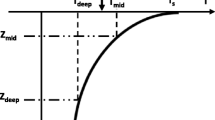Abstract
Two simple models are presented for describing the surface energy budget above vegetated surfaces. One is the traditional single-source model that includes only one energy budget equation for the entire canopy-soil system, and the other is the double-source model that includes separate energy budget equations for the vegetation canopy and the underlying soil surface. In both models, the bulk transfer coefficients needed to solve the energy budget equations are parameterized as functions of leaf area index, leaf transfer coefficients, and soil surface roughnesses to obtain the best fit to values calculated by a standard multilayer-canopy model. The validity of these models was tested by comparing their performance with that of the multilayer-canopy model for simulation of the surface energy balance and nocturnal drainage flow above vegetation. Results show that the double-source model gives reliable estimations for all cases ranging from sparse to dense vegetation covers; the single-source model is only applicable to dense, fully-covered vegetation. It is also shown that sparse vegetation weakens nocturnal drainage flow, since it isolates the cool underlying soil surface from the atmosphere above the canopy. This phenomenon cannot be described by a traditional single-source model incorporated commonly in many atmospheric models; however, the double-source model adequately describes this process.
Similar content being viewed by others
References
Bhumralkar, C. M.: 1975, ‘Numerical Experiments on the Computation of Ground Surface Temperature in an Atmospheric General Circulation Model’,J. Appl. Meteorol. 14, 1246–1258.
Brutsaert, W.: 1979, ‘Heat and Mass Transfer to and from Surfaces with Dense Vegetation or Similar Permeable Roughness’,Boundary-Layer Meteorol. 16, 365–388.
Denmead, O. T., and Bradley, E. F.: 1985, ‘Flux-Gradient Relationships in a Forest Canopy’, in B. A. Hutchison and B. B. Hicks (eds.),The Forest-Atmosphere Interaction, D. Reidel Publ. Co., 443–480.
Jones, H. G.: 1983,Plants and Microclimate, Cambridge University Press, 1–323.
Kondo, J.: 1975, ‘Air-Sea Bulk Transfer Coefficients in Diabatic Conditions’,Boudary-Layer Meteorol. 9, 91–112.
Kondo, J., and Miura, A.: 1983, ‘Empirical Formula of the Solar Radiation at the Ground Level and a Simple Method to Examine an Inaccurate Pyranometer’, (in Japanese)Tenki 30, 469–475.
Kondo, J., Saigusa, N., and Sato, T.: 1992, ‘A Model and Experimental Study of Evaporation from Bare-Soil Surfaces’,J. Appl. Meteorol. 31, 304–312.
Kondo, J., and Watanabe, T.: 1992, ‘Studies on the Bulk Transfer Coefflcients over a Vegetated Surface with a Multilayer Energy Budget Model’,J. Atmos. Sci. 49, 2183–2199.
Kondo, J., and Yamazawa, H.: 1986, ‘Bulk Transfer Coefficient over a Snow Surface’,Boundary-Layer Meteorol. 34, 123–135.
Ross, J.: 1975, ‘Radiative Transfer in Plant Communities’, in J. L. Monteith (ed.),Vegetation and the Atmosphere 1, Academic Press, 13–55.
Takemasa, T., Cho, T., Kuroda, M., and Komoda, H.: 1988, ‘A New Expression for Diurnal Temperature Change in Dry Surface Layer of Sandy Soil’, (in Japanese with English summary),J. Agric. Meteorol. (Japan) 43, 305–310.
Watanabe, T., and Kondo, J.: 1990, ‘The Influence of Canopy Structure and Density upon the Mixing Length within and above Vegetation’,J. Meteorol. Soc. Japan 68, 227–235.
Yaglom, A. M.: 1977, ‘Comments on Wind and Temperature Flux-Profile Relationships’,Boundary-Layer Meteorol. 11, 89–102.
Yamada, T.: 1981, ‘A Numerical Simulation of Nocturnal Drainage Flow’,J. Meteorol. Soc. Japan 59, 108–122.
Author information
Authors and Affiliations
Rights and permissions
About this article
Cite this article
Watanabe, T. Bulk parameterization for a vegetated surface and its application to a simulation of nocturnal drainage flow. Boundary-Layer Meteorol 70, 13–35 (1994). https://doi.org/10.1007/BF00712521
Revised:
Issue Date:
DOI: https://doi.org/10.1007/BF00712521




